The trails at Brookdale Nordic are in full-on late stage foliage right now, and if you visit at the weekend you can profit from the presence of Cynthia King and her Bits ‘n Bikes kiosk, dispensing snacks, good coffee, and mountain biking supplies and advice.

From the Risbridger, I made a squash and chickpea pie for supper tonight: onions, garlic, squash, chickpeas, Parmesan, heavy cream, white wine, thyme, smoked sea salt and nutmeg with a puff pastry top.
When you’ve ignored cookbooks as fascist rigour all your life, it’s a whole new world once you let your guard down.
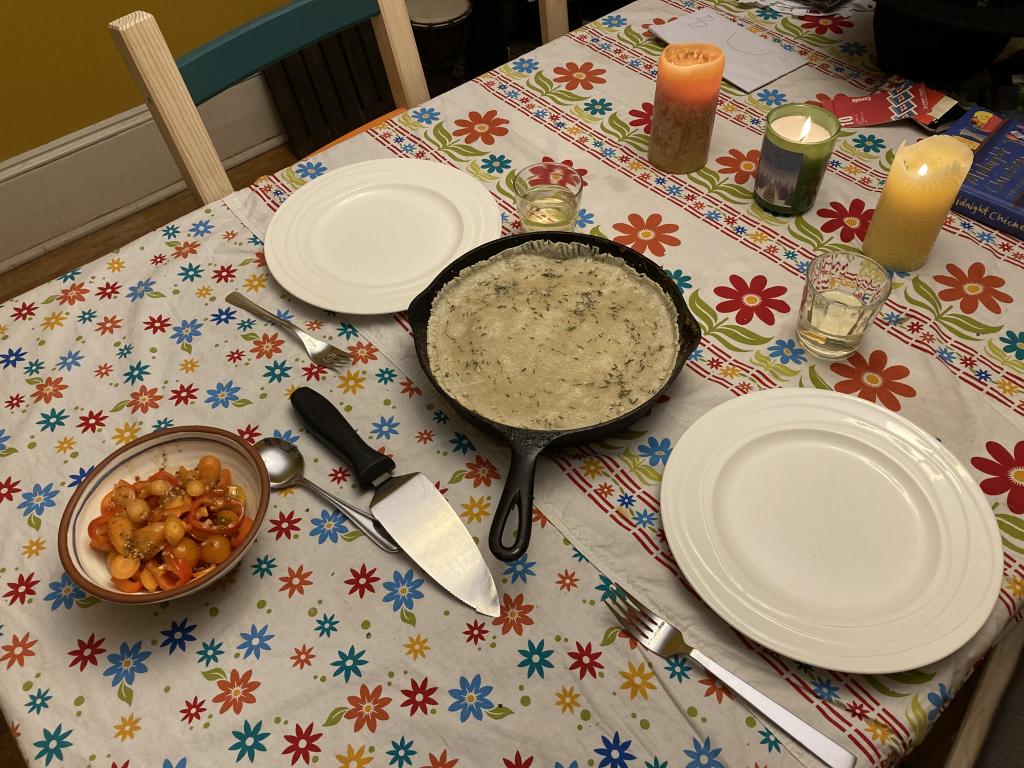
As part of Waste Reduction Week, the City of Charlottetown organized a Curbside Giveaway today:
A curbside giveaway will take place on Sunday, October 25. This event provides Charlottetown residents a new way to get rid of clutter and find new treasures. Those wishing to participate are encouraged to place unwanted items that are in good condition at the end of the driveway/curb and follow all Curbside Giveaway etiquette, as detailed at the City’s website below. All items must be cleaned/disinfected before being placed at the curb and after taken to their new home. All unclaimed items must be removed from the curbside by sundown on October 25.
I’m on a critical path schedule to empty Catherines studio before the end of the month, and so this came along at exactly the right time.
And it worked: by the end of the day everything I put out was gone, save a microwave oven and a teapot.
Among the things that found new homes: three armchairs, two desk chairs, a wooden stool, an old wooden barrel, an electric drill, an electric jigsaw, a desk lamp, a set of IKEA shelves, two artist easels, a cobbler’s clamp, a shoe rack, a whiteboard, a box of extension cords, three large colourful pillows, two fleece blankets, and a framed watercolour.
I would have taken a photo of everything, but as quickly as I brought things to the sidewalk, they were gone.
This was a huge help: it was the push I needed toward the cleanup finish line, it kept things out of the garbage, and a bunch of people got things they needed, for free.
Word on the street is that the Charlottetown Farmers’ Market will move back inside next week, making today the final iteration of the COVID-inspired outdoor rearrangement.
I managed to convince myself, and then Oliver, that we should bicycle to the market this morning, as it would be our last opportunity to cycle all the way out to the industrial edge of town to pick up smoked salmon bagels before Gallant’s comes back to the market with everyone else.
When I say that I “convinced” Oliver, that’s something of an exaggeration; despite his (occasionally very loud) protests about the cold, and his sore hands, however, he did it. All 7½ km, including a jaunt out to Riverview County Market (where Oliver executed a completely independent pumpkin purchase), and a visit to the Receiver Brass Shop for bread (all but gone from the shelves by the late hour of our arrival).
As in all previous such days that started sideways, we ended the trip tired but content.
While I know many market vendors are looking forward to moving back inside, leaving the need to set up tents and tables, to say nothing of the wind and rain, behind, I will miss the outside. Much less claustrophobic, much less COVID-nervousness-inducing, and with the bonus of breaking us out of longstanding habits and buying from vendors we’d long ignored for no other reason than well-worn ruts in our Saturday routine (yes, curried ketchup vendor, I’m looking at you!).
See you next Saturday.
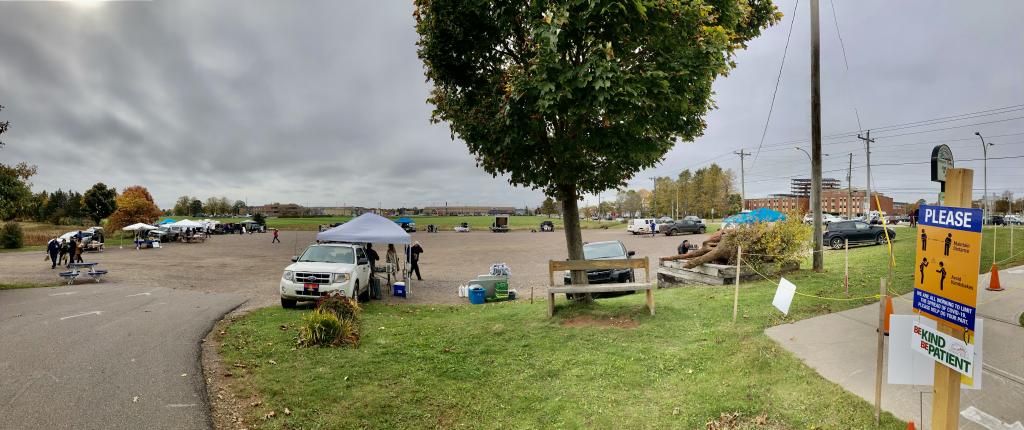
Refika Birgül’s video guide to making right proper hummus has dramatically upped my hummus game.
Ever since I started using chickpea water in place of eggs I’ve had chickpeas coming out of my ears; hummus has been one outlet for them. Alas my hummus was the consistency of stale Play-Doh and tasted not much better. Until I followed Refika’s guidance.
The key points that took my hummus to another level:
-
I removed the skins from the chickpeas. Previously this had seemed absurdly time-consuming, and I’d never done it. Refika’s video shows a really easy way to do this.
-
I used garlic. Even though garlic is one of the foundational ingredients of hummus, I’d always left it out as a “nice to have.” Turns out it’s a “need to have.”
- A full eight minutes in the food processor, with an ice cube added every few minutes to keep things cool. That’s about 4 times longer than my usual, and the extra time transports the hummus from Play-Doh to silky smooth, rich, and heavenly.
The hummus I made today was so good that it’s what we had for supper: hummus with warmed bread, hummus with carrots, hummus with apples, hummus with crackers.
Pro tip: you can get twice as much tahini, that’s twice as good, from Brighton Clover Farm.
Thanks to Thelma for starting me down this road.
 ,
, 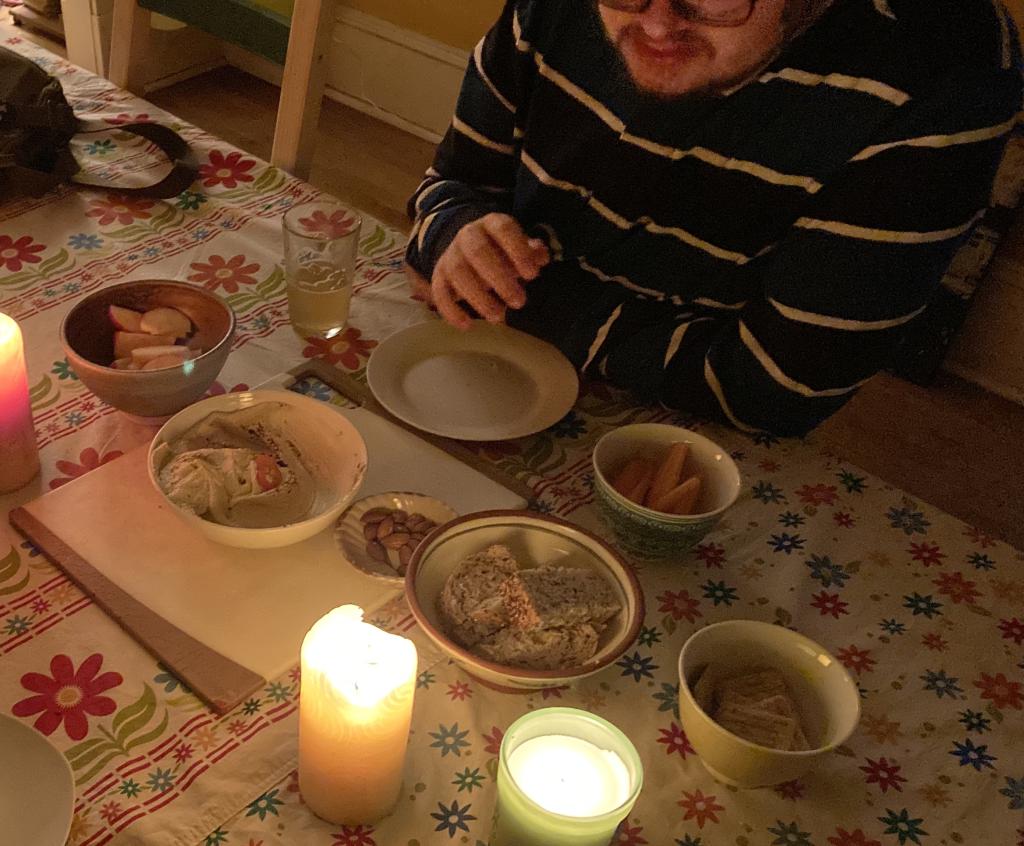
The staff at Receiver Coffee have been the most consistently and unrelentingly face-masked through coronatimes, and so when I noticed personable barista Joel Fitzpatrick again wearing his eyeglasses after a long time without (“I can’t see without my glasses, but I can’t see with my glasses fogged up either” was how he explained it when they first re-opened), I asked him what had changed.
He had a new mask, he explained, one that was comfortable and worked with his eyeglasses: a Medium Rare, from The Cook’s Edge, at the corner of Sydney and Pownal.
I stopped by and picked one up this afternoon. $20 each, so not your cheap dime-store mask, but well-built and, as Joel-certified, it’s comfortable and works with my eyeglasses (meaning they don’t fall off and they don’t fog up). Recommended.
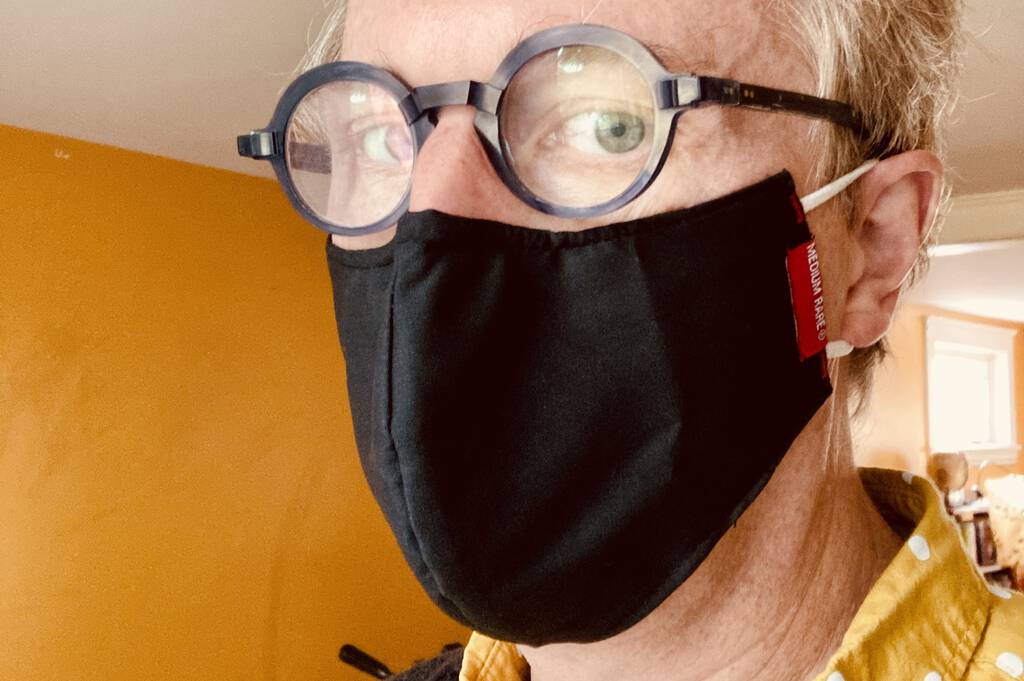
I’ve fallen hard for Ella Risbridger.
I found my way to her through Cupboard love: my biggest romances always begin in the kitchen, which led me to her website, and to her writing about her late partner, and his cancer. And, ultimately, to Midnight Chicken, her cookbook cum memoir. Wherein she writes:
I always start with a cup of tea. Writing this down it feels simultaneously absurdly English, and also not at all English, to have a proper cup of tea in the morning. Yorkshire, with a splash of milk and a teaspoon of sugar (brewed in the cup, milk and sugar and the teabag waiting for the kettle to boil), or Earl Grey with a brief twist-and-pinch of lemon. Lady Grey, Lapsang Souchong, green, red. Begin with a big mug of tea. Or maybe you’d rather have coffee. Three spoonfuls of ground beans in the bottom of the cafetiere, water just off boiling, and the bold crema that emerges when you press the plunger down, all glass and silver and daringly continental. I take mine black, first thing. Black, and back to bed - and perhaps that’s a good rule, for the morning: however you begin, take it back to bed. I set the alarm ten minutes earlier just for this. Some people meditate; I make to-do lists in bed with a mug of something hot. Propped up against the pillows, cup in one hand, pen in the other, contemplating the day ahead: it’s sort of like a battle plan.
When I was a little girl, every day I used to tell my mum: this is my Big Plan, and this is my Little Plan. I still do this, and I always begin both plans with breakfast. Partly because that or way the to-do list gets off to a good start, and partly because breakfast is important. Old wives and young nutritionists are united on this one: eat breakfast, and eat breakfast well. Breakfast like a king, the old saying goes. And I do. So should you. A small space carved out at the very beginning of the day just for you - it makes everything else smoother, tidier, easier.
Reading this, I became conscious that my morning routine, for as long as I can remember, has seemed a frantic giant slalom, a race to get myself up, get Oliver up, get us abluted and dress and fed and ready for the 9:30 a.m. gong, when our respective days start formally.
A decade ago, I had yet to become a skier in this race, having shirked all responsibility for the morning, save walking Oliver to school, to Catherine. And even the walking-to-school part was in some doubt, as I wrote in 2007:
Yesterday I lollygagged in bed 10 minutes later than usual. I was in no danger of falling out of line, but from Catherine’s reaction — “are you taking Oliver to school today?” — it was obvious that she still harbours some doubts about my long-term abilities in this regard. Indeed I think that part of my steely resolve on this issue is to simply to demonstrate to Catherine that I am not a total lay-about and that it is possible for me to make some contribution to the efficient running of the household, no matter how small it might ultimately be.
I am proud that I conquered at least some of my layabouty tendencies, and did, indeed, walk (and, later, drive) Oliver to school for the rest of that school year, and the 11 school years thereafter.
Eventually, though, sleeping in until the last minute, jumping out of bed, and getting Oliver to school became untenable: while Catherine was bound and determined to make Oliver’s breakfast and lunch every day (a stab at the darkness, I think, and proof to herself that she was still whole), eventually the balance of responsibilities had to shift. I started to get Oliver rousted (not always a simple task), and then started to make him breakfast, and, eventually, took on the entire party. And I did this, against my worser nature, with jaw clenched and eyes on the leave-for-school deadline.
It worked, but it cast the day in a cruel light, and reading Risbridger write about a “small space carved out at the very beginning of the day just for you” seemed so overwhelmingly attractive, that my body, traditionally primed to fight back viciously against any attempt to wake up before the absolute latest possible time (8:00 a.m. in the recent structure of the family day), graciously consented to allow me to wake up, without an alarm, at 7:05 a.m. yesterday.
At which point I went downstairs, boiled the kettle, made myself a cup of Lady Baker’s English Breakfast, and sat myself down on the big orange chair in the living room (I could not bring myself to go for the total Risbridger and go back to bed). In the fumble to accomplish this, I forgot my phone upstairs, which left me free to not check the latest COVID death count but, instead, to continue reading Midnight Chicken.
By the time the 8:00 a.m. alarm went off upstairs, I was, true to promise, primed for a “smoother, tidier, easier” morning.
And I did it all over again this morning, albeit with an Assam tea, which seemed better suited to the task.
As it happens, I was able to invoke this life lesson at an Autism Society zoom last night, led by Peter Mutch. It turns out that what I found my own circuitous route to is called self-care in the mental health game; that was Peter’s focus last night, and while he covered things ranging from muscle relaxation and diaphragm breathing to walks in the woods, the idea of taking time for yourself, time that can feel needlessly self-indulgent, was key to it all. I was happy to be able to share my morning tea story with the assembled.
Meanwhile, Midnight Chicken is just such a terrific book, the kind of book that I feel I should immediately purchase for everyone I know. Here is Risbridger writing about the joy of making morning pastries:
And then you offer a little platter of miniature pastries to your people, and everybody tells you how wonderful you are, and you have done nothing but be gloriously lazy and make pastries on the sofa. Serve these pastries with very hot coffee made in one of those natty little Italian espresso pots. Having wanted such an espresso pot for years, I recently acquired one, and it is an endless joy to me. I recommend, if you can, fulfilling small dreams like this as often as possible.
And on pikelets (“like crumpets, but untidy”):
Now whisk like billy-o. Keep whisking: 3-4 minutes of whisking with your whole strength. Come on, you’ll get an hour to rest in a minute.. This puts the holes in the pikelet, which sounds like an old-fashioned idiom for breaking something (‘By Jove, that’s put the holes in the pikelet!’) but isn’t: the bubbles of air you’re beating into the mixture become the holes when you griddle it. Cover the bowl with a clean tea towel, and take your tea back to bed.
After an hour or so (it’ll stand a little bit longer, so don’t worry if you’re at a good bit of your book, or otherwise occupied), come back and check the mixture. It should be bubbly and frothy, and about half as big again as when you left it. Stick your largest frying pan over a medium heat, adding a drizzle of oil if your pan’s not non-stick.
Her recipe for the eponymous Midnight Chicken is, almost, enough to make me consider breaking my vegetarian vows and tracking down a chicken.
I can’t afford to buy a copy for all of you, so please go and order one from The Bookmark.
The Glow from Sylvan Esso, with backing vocals by Molly Sarlé and Alexandra Sauser-Monnig.
Together with Sylvan Esso’s Amelia Meath, Sarlé and Sauser-Monnig are Mountain Man.
Sarlé has a solo career (and a smashing Tiny Desk to go with it).
As does Sauser-Monnig, as Daughter of Swords. She has a Tiny Desk too.
No matter the permutation or combination, there is music to be reckoned with there.
When one of the installations in the Rooted in Art project went up next door, and I discovered that all of the trees in the city have an ID number, as part of an “urban tree inventory,” I got very curious about that data, and I requested a copy from the City of Charlottetown. This request was turned around quickly: I needed to sign and return a “digital data agreement,” and I received a CSV file with records on 10,000 trees shortly thereafter.
It turns out that the inventory is not of every tree in the city, only the “street trees,” as described here. One of the things I gleaned from that explainer is that we have too many maple trees. Apparently a diverse tree population doesn’t have more than 10% of the same species; the inventory counts 24% Norway maples.
To run this test myself, I imported the CSV file into a MySQL table, and ran this query:
select count(*) from `trees`.`UrbanTreeInventory` where `species` = 'Maple Norway (Acer platanoides)'
Sure enough, there are 2,384 Norway Maple trees in the inventory – 24% of the total.
There are 133 species in the inventory in all; here are the top 10, by count:
2384 Maple Norway (Acer platanoides)
1372 Spruce White (Picea glauca)
787 Linden Littleleaf (Tilia cordata)
537 Birch White (Betula papyrifera)
451 Maple Red (Acer rubrum)
374 Oak Red (Quercus rubra)
362 Ash Green (Fraxinus pennsylvanica)
220 Maple Sugar (Acer saccharum)
166 Maple Silver (Acer saccharinum)
138 Ash White (Fraxinus americana)
This comes from this MySQL query:
select species,count(*) as howmany from `trees`.`UrbanTreeInventory` group by species order by howmany DESC
The diameter of each tree is in the inventory too; there are 73 trees with a diameter of more than 100 cm. To see these I used this MySQL query:
select species,latitude,longitude,diameter from `trees`.`UrbanTreeInventory` where diameter >= 100 order by diameter DESC
I exported the result from that query as a CSV and imported it into geojson.io to see these big trees on a map:
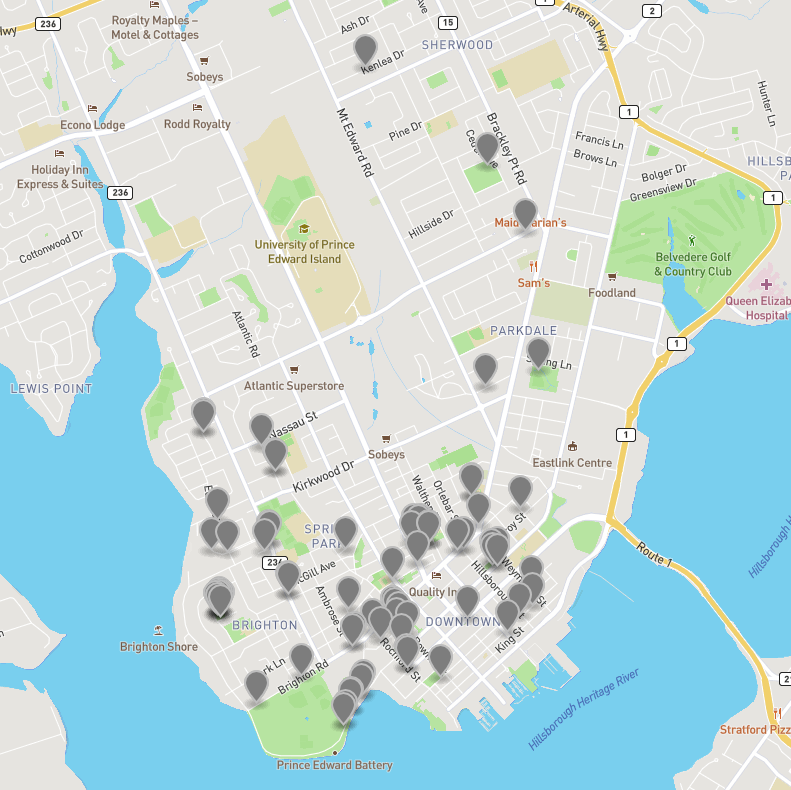
The tree with the largest diameter is 155 cm across, a silver maple in St. Clair Park in Brighton. I had to go and take a look at this tree for myself, so I stopped writing this blog post, grabbed my bicycle, and went to do some field research:
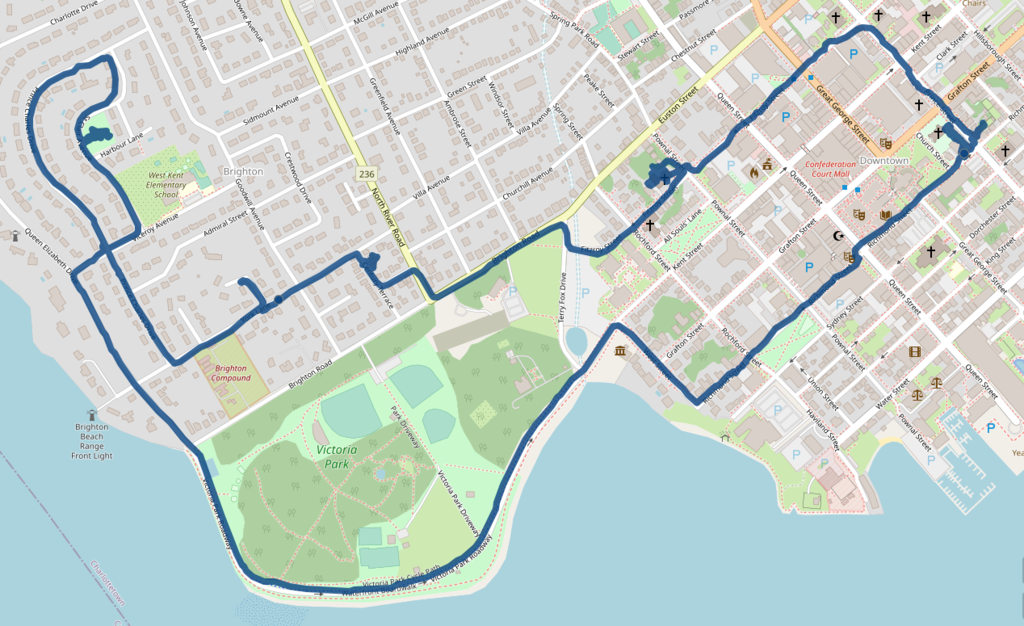
Careful map-readers will note that I made two stops along the way: first at Lady Baker’s Tea to pick up some organic Assam tea (with th bonus of a chat with friends Sandy and Katherine), second at Brighton Clover Farm to purchase some sumac and some green wheat.
Continuing on through to deepest, toniest Brighton, I came to the aforementioned St. Clair Park, upon which I’d never laid eyes; truth be told, I’d never noticed that St. Clair Avenue runs up the western side of West Kent Elementary School.
Once I arrived at the park, I took advantage of having added the large silver maple to OpenStreetMap just before I left; this allowed me to walk right up to it, phone in hand:
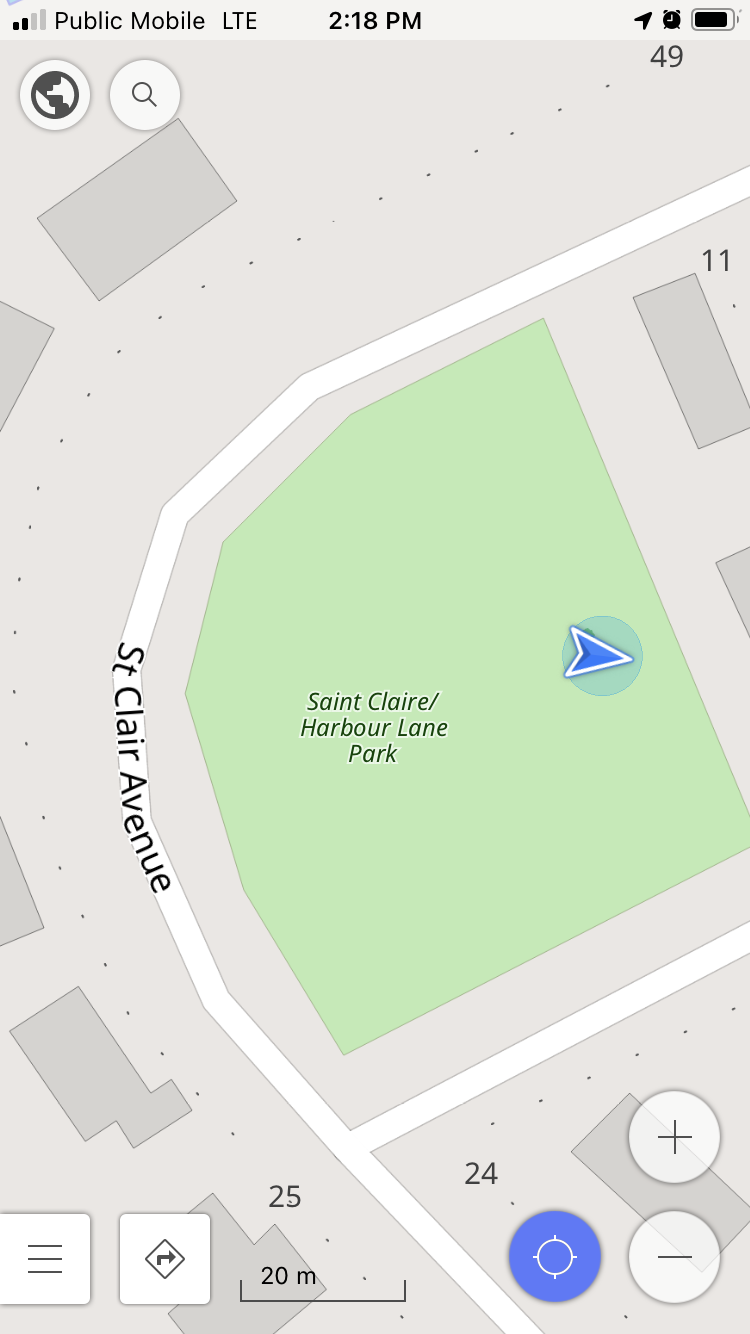
And it is, indeed, a grand tree:
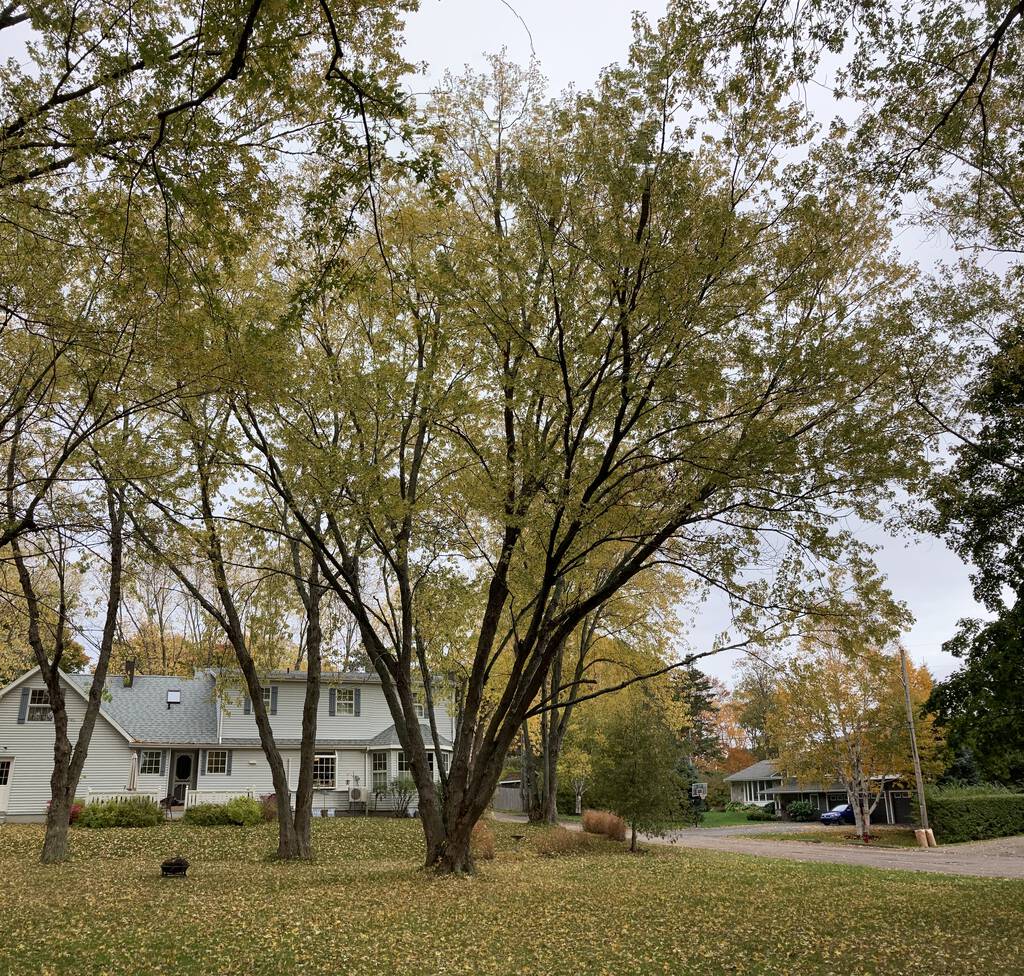
It’s 155 cm diameter can be explained, in part, by it’s hydra-headed base:
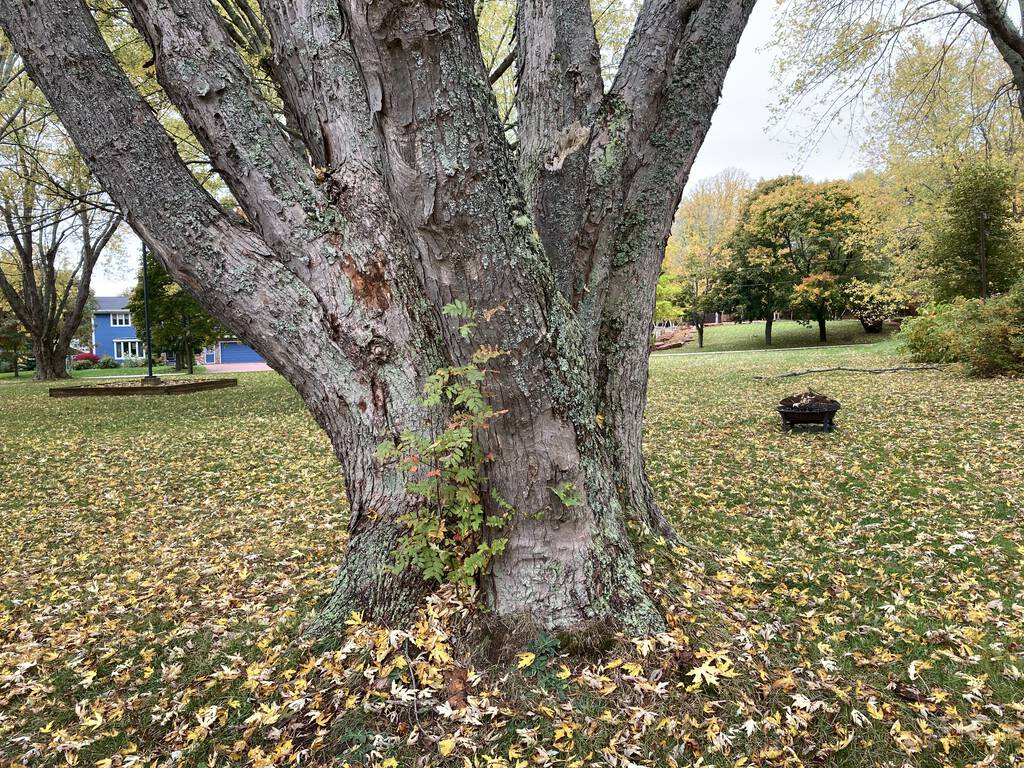
St. Clair Park turns out to be home to eight of the top-100 trees, by diameter, all of them silver maples:

While I was standing in St. Clair Park, looking at its impressive community of trees, I wanted to know more about each one, but I didn’t have ready access to the inventory database on my phone. Which has me thinking that a mobile “hey, what’s that tree?” app might need to be added to my project list.
So, what do we do about having too many maples?
Here’s what the city has to say:
- Plant fewer maple trees… but don’t stop planting them as we don’t want a big gap in the succession of the urban forest where there are no maples
- Stop planting Norway maples – they are invasive. The City has not been planting Norway maples in our Parks for over 13 years and have not been planted as street trees for a number of years
- Look for and plant alternate tree species that serve the same purpose (foliage color, shade tree, etc.) in the urban forest. More tree species means greater biodiversity and forest health
We may have too many maple trees for our own good, but those ones in St. Clair Park are awfully impressive, and I recommend you pay the park a visit while they are still in leaf; it’s a wonderful part of the urban landscape to experience in the autumn.
 I am
I am